Weeping tree
Weeping trees are characterized by soft, limp twigs.[1] This characterization may lead to a bent crown and pendulous branches that can cascade to the ground. While weepyness occurs in nature, most weeping trees are cultivars.[1] Because of their shape, weeping trees are popular in landscaping; generally they need a lot of space and are solitary so that their effect is more pronounced.[2] There are over a hundred different types of weeping trees. Some trees, such as the cherry, have a variety of weeping cultivars. There are currently around 550[3] weeping cultivars in 75 different genera, although many have now disappeared from cultivation.[4]
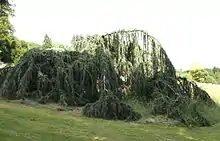
Weeping Atlas Cedar
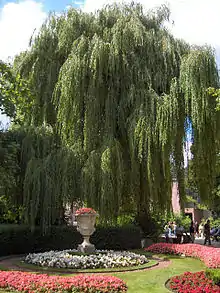
Golden weeping Willow: Salix Sepulcralis Group 'Chrysocoma'
List of weeping trees
Weeping conifers
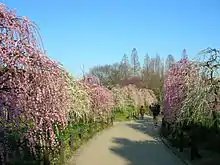
Weeping Flowering Apricot
- Cedrus atlantica 'Glauca Pendula', Weeping Blue Atlas Cedar
- Cupressus nootkatensis 'Pendula', Weeping Nootka Cypress
- Cupressus nootkatensis 'Pendula Vera', True Weeping Nootka Cypress
- Cupressus sempervirens 'Pendula', Weeping Mediterranean Cypress
- Juniperus virginiana 'Pendula', Weeping Eastern Red Cedar
- Juniperus scopulorum 'Tolleson's Blue Weeping', Tolleson's Blue Weeping Juniper
- Larix decidua 'Pendula', Weeping European Larch
- Picea abies 'Inversa', Inversed Norway Spruce
- Picea abies 'Pendula', Weeping Norway Spruce
- Picea breweriana, Brewer's Weeping Spruce
- Picea glauca 'Pendula', Weeping White Spruce
- Picea omorika 'Pendula', Weeping Serbian Spruce
- Pinus strobus 'Pendula', Weeping Eastern White Pine
- Pinus patula, Mexican Weeping Pine
- Sequoiadendron giganteum 'Pendulum', Weeping giant sequoia
Weeping broadleaf trees
_in_Hyderabad%252C_AP_W_IMG_7645.jpg.webp)
Weeping Fig
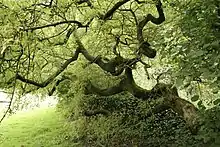
Weeping Ash
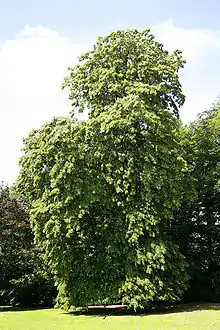
Weeping Silver Linden
- Acer campestre 'Eastleigh Weeping', Weeping Eastleigh Field Maple
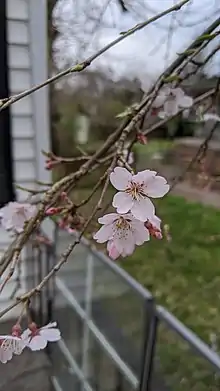 Weeping Cherry blossoms
Weeping Cherry blossoms - Acer campestre 'Pendulum', Weeping Field Maple
- Acer campestre 'Puncticulatum', Weeping Speckled Field Maple
- Acer negundo 'Pendulum', Weeping Boxelder Maple
- Acer platanoides 'Pendulum', Weeping Norway Maple
- Acer pseudoplatanus 'Pendulum', Weeping Sycamore
- Aesculus (Carnea Group) 'Pendula', Weeping Red Horse Chestnut
- Amorpha fruticosa 'Pendula', Weeping Desert False Indigo
- Aspidosperma quebracho-blanco 'Pendula', Weeping White Quebracho
- Betula pendula 'Youngii', Young's Weeping Birch
- Betula pubescens 'Pendula', Weeping Downy Birch
- Betula pubescens 'Pendula Nana', Gazebo Downy Birch
- Cercidiphyllum japonicum 'Pendulum', Weeping Katsura
- Fagus sylvatica 'Pendula', Weeping Beech
- Ficus benjamina, Weeping Fig
- Fraxinus angustifolia 'Pendula Vera', True Weeping Narrow-leafed Ash
- Fraxinus excelsior 'Pendula', Weeping Ash
- Ilex aquifolium 'Pendula', Weeping Holly
- Malus 'Louisa', 'Louisa' Weeping Crabapple
- Melaleuca leucadendra, Weeping Tea tree
- Morus alba 'Chaparral', 'Chaparral' weeping Mulberry
- Prunus mume 'Pendula', Weeping Flowering Apricot
- Prunus spachiana 'Pendula', Weeping Japanese Cherry
- Prunus spachiana 'Pendula Rosea', Weeping Spring Cherry
- Prunus spachiana 'Pendula Rubra', Red Weeping Spring Cherry
- Prunus × subhirtella 'Pendula Plena Rosea', Weeping Higan Cherry
- Pyrus salicifolia 'Pendula', Weeping Willow-leaved Pear
- Salix babylonica 'Babylon', Weeping Willow
- Salix Sepulcralis Group 'Chrysocoma', Golden weeping Willow
- Styphnolobium japonicum 'Pendulum', Weeping Pagoda Tree
- Tilia tomentosa 'Petiolaris', Weeping silver Linden
- Ulmus glabra 'Camperdownii', Camperdown Elm
- Waterhousea floribunda 'Sweeper', Weeping Lilly Pilly
References
- Platt R (1959). 1000 Questions answered about Trees. Toronto: General Publishing Company. ISBN 0-486-27038-6.
- Peltier P, Boland T. "Bring grace to the landscape with weeping trees". Retrieved December 4, 2009.
- Govaerts, R., Michielsen, K. & Jablonski, E. (2011). Untraced Weeping Broadleaf cultivars: an overview. Belgische Dendrologie Belge 2009: 19-30.
- Govaerts, R., Jablonski, E. & Michielsen, K. (2009). Hänge- oder Trauerformen von Gehölzen - unauffindbare Sorten - vielleicht wissen Sie etwas darüber ? Ginkgobätter 116: 24-27.
External links
| Wikimedia Commons has media related to Weeping trees. |
This article is issued from Wikipedia. The text is licensed under Creative Commons - Attribution - Sharealike. Additional terms may apply for the media files.
